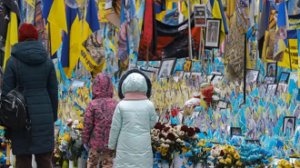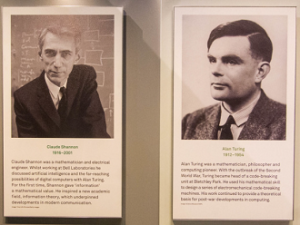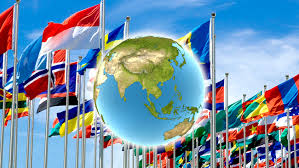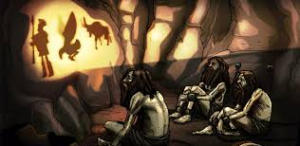
Lasting peace or truce
No peace that subjugates a nation will be lasting, oppression is always a situation of indignity for a people, but diplomatic negotiation is better than any war, this seems to be a principle for Ukraine today because of the lives lost (photo).
lasting, oppression is always a situation of indignity for a people, but diplomatic negotiation is better than any war, this seems to be a principle for Ukraine today because of the lives lost (photo).
Meanwhile, US Secretary of State Marco Rubio thinks along these lines: “to end this conflict in a lasting and sustainable way” and Putin too has stated a very similar view, since he has the upper hand and has conquered several Ukrainian territories by war and is recovering the Russian region of Kursk.
Peace cannot be the “pax romana”, as we have already analyzed in previous posts, the one that the Roman Empire considered when it dominated a territory, we have also analyzed the financial interests here, Ukraine is rich in rare earths and is also a major grain producer.
Russia stands to gain from the lifting of its financial blockade and the US will want Ukraine’s land, but Europe remains wary of future advances by Russia and NATO.
In the Middle East, Syria seems to be moving towards a constitutional path, a five-year plan proposed by Syria’s interim president Ahmed al Sharaa, and the Islamic State group has also lost its strength completely.
In the south of the Arabian Peninsula, meanwhile, the US is fighting against the Houthis, who are attacking American ships in the Persian Gulf. There too, it is necessary to avoid an escalation that is growing.
Iran denies this, but it is virtually certain from the Shiite position that there is some support for the group in Yemen.
The newspapers report that the Israeli cabinet is preparing to resume negotiations with Hamas, since the first phase ended on March 2. Hamas’ demand is also for a lasting peace and to overcome this current phase surrounded by mistrust.
There, too, we problematize the “pax romana”: without establishing a free territory for the Palestinian people, any agreement will only be a truce, and the war can be resumed at any moment if there is conflict or provocation on either side.
The scenario, although very delicate, is optimistic, diplomatic means are working and international political forces have come out of their immobility, hope is high.
Language, being and reconciliation
Since ancient philosophy, language has been considered ontologically linked to Being, Plato’s World of Ideas (eidos) is nothing other than this, for Aristotle language is a “tool” of thought that allows us to represent reality.
been considered ontologically linked to Being, Plato’s World of Ideas (eidos) is nothing other than this, for Aristotle language is a “tool” of thought that allows us to represent reality.
However, modernity, under the pretense of realist objectivity, has ignored this simple reality where any action begins with thought and is transformed into language, in the words of contemporary thinker Heidegger, language is the “dwelling place of being”.
The “language of machines” or the codification of thought already expressed in a human “message” and transformed into codes, is not exactly what should be thought of in ontology, all of Heidegger’s texts and also those of the philosopher Byung-Chul Han complain about this technical view of language, but the 20th century began with the so-called linguistic turn.
Thus, the language thought of by Alan Turing and Claude Shannon is confined to the universe of machines, while language thought of ontologically is the “opening up of being” and the search for a universe of fulfillment and reconciliation, as Rainer Rilke (1875-1926) says: “We, the violent, last longer. But when, in which life, will we be finally open and welcoming?”
Byung-Chul Han recalls that the epic poem Iliad begins with the phrase: “Aira, Goddess, celebrates Achilles’ wrathful rage, which brought so many sorrows to the Achaeans, and cast countless souls into Hades.” We’ve already written several posts about the myth of Hades, the god of the underworld where souls go, and violence still marks our civilizing process.
Language as an expression of our thoughts and our interiority cannot be separated from active life (Hannah Arendt and Byun-Chul Han). Heidegger, who had a strong influence on both of them, sees it as a bridge linking the inside and outside of man, in such a way that speaking is thought of as an activity that takes place through man and is thus an ontological act (photo – A mural in Teotihuacan, Mexico, c. 2nd century).
This vision of language “through man” thus precedes its dissemination by the media and cannot be thought of as mere transmitters and receivers, since whatever the medium, it is preceded by human thought and language and in it the being “opens up”.
It can therefore be said that violence is an aspect of the lack of openness of being, motivated by thought and this is constructed by methodologies and ways of understanding reality as having a single path to violence where reconciliation may seem impossible.
Man and reality itself are not binary: Being and Non-Being, affirmative and negative, in man because he has sensitive and cognitive inner stages where the engines of thought are activated, and in reality because of the discoveries of quantum physics and the complex universe that astrophysics has created.
Communication, Shannon and data
Born in the small town of Gaylord, Claude Shannon watched the creation of telegraphs using the barbed wire of the mountain farms in his region from an early age. He soon built his own telegraph, unlike the telephone companies of the time, in the countryside they continued to use barbed wire to send messages as telegraphs.
Shannon watched the creation of telegraphs using the barbed wire of the mountain farms in his region from an early age. He soon built his own telegraph, unlike the telephone companies of the time, in the countryside they continued to use barbed wire to send messages as telegraphs.
Shannon went to study at the University of Michigan, interested in mathematics and communication, where he discovered an advertisement asking for monitors for Vannevar Bush’s famous MIT Laboratory, where students finishing their theses were looking for a machine to tabulate data, unlike Charles Babbage’s historic English computer, this was just a machine to tabulate data, we could say a nascent data science.
The MIT laboratory was where “professors and students turned to the Differential Analyzer in moments of desperation, and when it was possible to solve equations with a margin of error of 2%, the operator of the Claude Shannon Machine was happy” (Gleick, 2013, p. 181).
The circuits of this machine were made up of ordinary switches and special switches called relays, direct descendants of the telegraph and predecessors of the logic of 0 and 1, whose logic was known to Bush, called Boole’s Algebra, which Shannon learned there.
This was where the data processed by Bush’s differential analyzer and the new logic of 0 and 1 came together, the other point we made in the previous post, the concern with an intelligible language for the machine and the problem of coding and decoding messages modified into electrical signals in the logic of 0 and 1.
Claude Shannon’s important point and great collaboration, expressed in his Mathematical Theory of Communication, determined how many coded signals would be needed to maintain the integrity of the message before the coding process.
The so-called Shannon Theorem determines that a number of signals twice the highest frequency communicated through the channel are required between the sender, who precedes the message sent, and the receiver, who decodes the signal and reconstructs the message. In order for this message to remain unchanged, the number of signals in Shannon’s Theorem must be observed.
The noise problem depends exclusively on the distance and the way the signal is captured and sampled (segmented into a quantity that complies with the theorem) while the sender and receiver problem depend on the transformation of the message into a signal (i.e. the transformation of an analog signal into a digital signal and vice versa).
The message sent and the message received depend only on human sources, as the sender and receiver are electrical, digital or photonic devices. Quantum devices are already being developed and could represent greater speed and signal integrity.
Gleick. (2013) Informação: uma história, uma teoria e uma enxurrada. (Information: a history, a theory and a flood). Trad. Augusto Cali. Brazil, São Paulo: ed. Companhia das Letras.
Thought and information technology
The origins of almost all realities (if we don’t consider the divine and eternal) come from human thought, the idea of politics in the Greek polis, the idea of the “art of war”, from the law codes of Hammurabi (1792 to 1750 BC) to modern contractualists, compilations of religious treatises, epistemological constructions of the sciences and computer science could not be left out.
consider the divine and eternal) come from human thought, the idea of politics in the Greek polis, the idea of the “art of war”, from the law codes of Hammurabi (1792 to 1750 BC) to modern contractualists, compilations of religious treatises, epistemological constructions of the sciences and computer science could not be left out.
In 1900, when physics and mathematics seemed to give an air of precision and certainty to the scientific universe, positivism still reigned in law, a German mathematician David Hilbert proposed 23 “final” problems for mathematics at an International Congress in Paris in 1900.
Among these was the second problem: the finitist solution to the consistency of the axioms of arithmetic, which together with the sixth problem, which was the axiomatization of physics, seemed to give a logical and precise finish to all of science, but there had already been a return to the question of Being through Husserl and Heidegger, and this returned thought to human complexity.
Kurt Gödel, a member of the Vienna Circle who eschewed this logic and for this reason was called a neologicist, proved the incompleteness of the second problem, that arithmetic was either consistent or complete, thus remaining in a paradox, called Gödel’s Paradox.
The question of arithmetic is important to understand the origin of the idea of algorithms, which were previously just formulas like Bhaskara’s formula (for 2nd degree equations), complex solutions to differential equations, while physics had the problem of formulating all of physics in a single theory, the so-called Standard Theory of Physics, but quantum mechanics and the theory of general relativity, where time and space are not absolute, changed this scenario.
The meeting of Claude Shannon and Alain Turing, who were working on secret projects to code transmissions (made for the Roosevelt government) and decode the Enigma machine captured from the Nazis (Turing’s secret project) will create a new event.
Unable to talk about their secret projects (Gleick, 2013, p. 213), they talked about Gödel’s paradox and wondered about the possibility of the machine elaborating thoughts, even if it was something limited, and both developed theories about language and algorithms.
While Turing devised a state machine that, through back and forth movements of a tape recording symbols, would produce intelligible sentences, Shannon worked on a similar model (using a theory called Markov chain) that, through finite vocabularies, could compose sentences and formulate broader ideas.
Alain Turing’s definitive contribution was the so-called Finite State Machine, whose model was completed by Alonzo Church, while Claude Shannon left the contribution of a Mathematical Theory for Communication, his theory establishing the amount necessary for the information transmitted not to be damaged, but within the limits of the “machine”.
The reductionist idea that it is possible to carry out actions without a necessary, elaborate, meditated and tested thought is part of current pseudo-scientific narratives.
Gleick. (2013) . Informação: uma história, uma teoria e uma enxurrada. (Information: a history, a theory and a flood). Transl. Augusto Cali. Brazil, São Paulo: Companhia das Letras.
Thinkers with full bellies
Modern society is characterized by an absence of serious developed thought. What is called “critical thinking” is nothing more than the rejection of any thinker who tries to think outside the ideological bubble, or of vulgar and superficial narratives.
of serious developed thought. What is called “critical thinking” is nothing more than the rejection of any thinker who tries to think outside the ideological bubble, or of vulgar and superficial narratives.
They don’t know about the great classical works, even those professed by Kant, Hegel or Marx, deep literature by Zolá, Vitor Hugo, Proust, Balzac, Camus or more current ones like George Orwell, James Joyce, Gabriel Garcia Marques or Jorge Luís Borges, Eurocentric in their shallow knowledge, preferring the contentless criticism of thinkers who challenge all current thinking as fragmentary: Heidegger, Gadamer, Peter Sloterdijk and Byung-Chul Han.
Their bellies are full of food that fills their stomachs, but it’s far from being the kind of food that provides a deep and well-founded critique of current thinking: decadent sociologism, little meditation (read Hannah Arent or Byung-Chul Han on the Vita Contemplativa) and little knowledge of even the late Enlightenment that they profess.
At most, they know Bauman’s liquid and Eurocentric thinking, Foucault’s biopolitics or Jean Jaurès’ revisionism, they don’t know Edgar Morin’s transdisciplinarity (he calls this partial intellectuality blind intelligence), Barsarab Nicolescu’s third-included and the quantum physics revolution (it’s no longer a binary dualism), thought is dated in modernity, and they don’t know its origin in ancient Greece.
It is necessary to deny authors who propose new paradigms so that their narrative, based on authors from the last century, is coherent. At best, they talk about original cultures without knowing the great modern African and Latin sociologists such as Achille Mbembe, Franz Fanon and Anibal Quijano.
The belly is full of a culture that is already outdated, even without the necessary updating and without a complete reading of the works on which the positions are based, the psychopolitics of Byung-Chul Han, the spherology of Peter Sloterdijk (Sphere I: bubles) and the transdisciplinarity of Morin cannot be understood, it is a shallow and incomplete revisionism due to the fragility of the readings.
The easy criticism and consequent narrative are based on the chaotic social and cultural scenario we face, without a complete and radical analysis that escapes the bubbles we are trapped in, that understands and updates thinking beyond idealistic dualism.
In fact, we need a few words and thoughts, but profound ones that are forgotten or dormant: what kind of hope do we have for today’s society? What kind of beliefs do we have that don’t involve power and domination? What kind of science is it that deals with the whole man so that it can also deal with every man? What is our relationship with the Other? (Lévinas, Ricoeur, Buber and others).
Without reading Thomas Aquinas, they will remain readers of only one book, without reading St. Augustine, they will not come out of Manichaeism, because evil is the absence of Love and Forgiveness.
Han, Byung-Chul. (2019) O que é poder? Trad. Gabriel Salvi Philipson. Brazil, Petrópolis, RJ: Vozes.
Sloterdijk, Peter. (2019) Esferas I: Bolhas. Trad. José Oscar de Almeida Marques. Brazil, São Paulo: Estação Liberdade.
Morin, Edgar. (2015) Introdução ao pensamento complexo. Trad. Eliane Lisboa. 5.ed. Brazil, Porto Alegre: Sulina.
Positive signs in the Middle East and negative in Eastern Europe
After the first phase of the negotiations, Hamas spokesman Abdel-Latif Al-Qanoua said on Saturday (08/03) that he sees positive signs in the negotiations for a second phase of the ceasefire with Israel, and 50 former hostages ask Netanyahu to implement a broad agreement on the conflict, Israel and Hamas disagree on the future of the conflict.
spokesman Abdel-Latif Al-Qanoua said on Saturday (08/03) that he sees positive signs in the negotiations for a second phase of the ceasefire with Israel, and 50 former hostages ask Netanyahu to implement a broad agreement on the conflict, Israel and Hamas disagree on the future of the conflict.
European countries, increasingly independent of American opinions, support the plan to rebuild the Gaza Strip. Unfortunately, last night Hamas militants came under heavy Israeli bombardment.
In Eastern Europe, the situation is becoming more and more dramatic, both on the battlefield where Ukraine is threatening to lose more territory. Putin wants to reach the port city of Odessa, which will make the war on the Black Sea more violent, and also to surround Ukrainian troops in their invaded territory in the Kursk region.
Ukraine has suffered huge bombardments, its energy infrastructure is increasingly compromised, Trump has withdrawn his support and now Ukraine no longer has the satellite images that allowed it to monitor the movements of Russian troops.
Although both sides of the conflict talk about ceasefires, the battlefield, the involvement of Europe, in practice, the ferocity of each side only grows and the militarization of Europe frightens any serious analyst, there is a bleak future in this conflict.
In a meeting between Ambassador Linda Thomas-Greenfield, the US representative to the United Nations (UN), and Brazilian Foreign Minister Mauro Vieira, held in Brasilia at the beginning of the month, Linda said that any solution in Eastern Europe must consider support for Ukraine, and this shows America’s good intentions.
The problem is that Russia rejects any concession of territory while Ukraine wants all of its territory back, as we’ve analyzed before there are interests in the region’s rare earth reserves, and this leads to an impasse.
The agreement on the transportation of grain, which passes through the Turkish-controlled Bosporus Strait, met on Friday (07/03) with no conclusions yet, but it is valid until May.
The statement by President Makron of France, who said that Russia was a “revisionist imperialist” referring to the Soviet period, was answered by Putin, who said that France had forgotten what “happened to Napoleon” who lost the war on Russian soil.
The world climate continues to be tense, but there are still efforts to come up with a proposal that will bring the opposing sides to a diplomatic negotiating table.
Serenity: choosing what is good
There is no serenity without reasonable choices about personal, social and spiritual life, even worse is the one who tries to eliminate one of the three. Without personal life there is no being-there (Heidegger’s Dasein), without social life we live in a bubble, and without spiritual life we do not develop our essence.
about personal, social and spiritual life, even worse is the one who tries to eliminate one of the three. Without personal life there is no being-there (Heidegger’s Dasein), without social life we live in a bubble, and without spiritual life we do not develop our essence.
Among the choices we have to make in life, they cannot involve only one of the three aspects: the personal only makes us selfish and narcissistic, without the social we become alienated and have difficulty understanding reality, and without the spiritual we do not have a true asceticism that elevates us as human beings.
On the occasion of the centenary of his fellow countryman, the great musician Conradin Kreutzer, in a 1949 conference in his hometown of Meßkirch, Germany, wrote the text on Serenity.
Heidegger questions the difficulty of thinking even at that time, and asks if it is not through music and singing: “is not music distinguished by the fact that it ‘speaks’ through the mere resounding of its notes and does not need everyday language, the language of words?” and: “is it already a commemoration, which involves the act of thinking?” (Heidegger, 2008, p. 10).
Heidegger questions the difficulty of thinking even at that time, and asks whether it is not through music and song: “isn’t music distinguished by the fact that it ‘speaks’ through the mere resonation of its notes and does not need everyday language, the language of words?” and: “is it already a commemoration, which involves the act of thinking?” (Heidegger, 2008, p. 10).
When remembering his hometown, he recalls that [due to the war]: “they had to abandon their villages and cities, expelled from their native soil… they became strangers… and those who remained? They are often even more uprooted (heimatloser) than those who were expelled. Every hour and every day they are tied to radio and television… the cinema transports them weekly to the unusual domains, of representation that simulates a world that is not.” (Heidegger, 2008, p. 16), showing the relationship with technology. If you lived in our day and age, you would see how visible the relationship that is maintained is, now not transporting you to other realities, but to unrealities that transport your mind to the vulgar.
Thus, the choices that must be made become more radical. More than ever, it is necessary not only to choose what is good and healthy, but to fight so that this awareness is not lost in illusions.
Heidegger, M. (2008) Serenidade (Serenity). Lisbon: Instituto Piaget.
Beyond pain: choosing life
No to war, hatred and indifference means going beyond pain. It is often difficult to go through differences of opinion, conflicts of culture and even ideologies, but this is exactly what pain implies as a normal contingency of life.
going beyond pain. It is often difficult to go through differences of opinion, conflicts of culture and even ideologies, but this is exactly what pain implies as a normal contingency of life.
Byung-Chul Han, in his analysis of painkillers, describes permanent anesthesia as one that limits not only feelings: “Pain is stopped before it can set a narrative in motion” (p. 72), and also: “Hell is just like a palliative well-being zone” (p. 73).
“Today, we are not willing to expose ourselves to pain. Pain, however, is a midwife to the new, a midwife to the entirely other” (p. 73), so it leads to an encounter and to life, ‘it allows only the prose of well-being, that is, writing in the sunlight’ (idem).
In the inability to understand pain as a process of change, it is often replaced by resilience, which can make sense with great obstacles or a great effort to overcome a certain circumstance of pain, but in many cases, it is just a stubbornness with situations that lead to true happiness, what Sloterdijk calls a “society of exercises”, efforts that do not lead to overcoming.
The Greeks had the myth of Sisyphus (we’ve already posted about this, see the image), a cunning king who defied Death and Hades, resulting in his being condemned to eternally push a stone to the top of the hill, Albert Camus has a book that talks about this and updates the theme.
True resilience understands that there is a new path, a pain that “midwives the new”.
When the people complained about the passage from Egypt to the promised land, saying that they missed the onions and leftovers they ate as slaves to Pharaoh, Moses rebuked them and said (Deuteronomy 30:19): “I take heaven and earth as witnesses against you today that I have set before you life and death, blessing and cursing. Choose life, that you and your descendants may live…”, indicating the path to freedom and the building of their nation.
Facing difficulties, pain and even afflictions in difficult times certainly requires resilience, but it cannot be confused with error, sheer stubbornness or “exercises” that lead to nothing and do not favor finding happiness.
Han, B. C. (2021) Paliative Society: pain today. Transl. Lucas Machado, Brazil, Petrópolis: Ed. Vozes.
Pain and ashes
The period of Lent is the 40 days after Carnival, as it was already part of the early church, coming from the Easter of the Jews, it is before Carnival, it recalls the Jewish Easter (Pesach), which has the meaning of passage or liberation, remembering the period when they were slaves in Egypt.
as it was already part of the early church, coming from the Easter of the Jews, it is before Carnival, it recalls the Jewish Easter (Pesach), which has the meaning of passage or liberation, remembering the period when they were slaves in Egypt.
Christian Easter is a renewal, it recalls the death and resurrection of Jesus. We are reading and remembering the book by Byung-Chul Han (who is not a Christian) where he talks about the ontological meaning of pain and its current erasure, clarifying: “we live in a society with increasing loneliness and isolation” (Han, 2021, p. 59).
The author quotes Viktor von Weizsäcker in his essay “The Pains”, where he characterizes pain as a “truth that has become flesh”, as a “becoming flesh of truth” (p. 61), and also “Everything that is true is painful” (idem).
Society without truths, says the author in the following passage, is “an unparalleled hell”, and “pain can only arise where true belonging is threatened. Without pain, then, we are blind, incapable of truth and knowledge” (p. 62).
So in Christianity and Judaism, the ashes and Passover as a way of of 40 days, appear to remind us of the dust we are and the path of salvation and belonging we must follow: “pain is distinction [Unterschied]. It articulates life” (pg. 63), ‘it marks boundaries’.
“Pain is reality. It has a reality effect. We first perceive reality in the resistance that hurts. The permanent anaesthesia of the palliative society derealizes [entwirklicht] the world” (p. 64) and ‘reality returns in the form of a viral counter-body’ (p. 65) wrote the author because it was the period of the pandemic.
So the ashes and the period of Lent for Christians is to renew the period of Jesus’ passion as its apex in Holy Week, where there is the apex of the pain of crucifixion and the apex of renewal that is his resurrection, Christians or not, this is the true and real logic of life.
If we don’t understand this, we become paralyzed by the pain of hatred, wars, indifference, various types of injustice, the exclusion of the Other, in short, the non-life that all this senselessness of pain causes, and so it is necessary to remember the dust of ashes, everything that passes and that only makes sense if we understand pain not as an end, but as a passage to life.
Han, B. C. (2021) Paliative Society: pain today. Transl. Lucas Machado, Brazil, Petrópolis: Ed. Vozes.
Pain and its meaning
In his book “Palliative Society: Pain Today”, Byung-Chul Han characterizes the being who has “objectified pain” as one who lives in a “purely bodily affliction”, because being “endowed with meaning [Sinnhaftigkeit] pain presupposes a narrative that inserts life into a horizon of meaning”, so without a bodily life linked to a greater meaning it is “a bare life emptied of meaning, which no longer narrates” (Han, 2021, p. 46).
Byung-Chul Han characterizes the being who has “objectified pain” as one who lives in a “purely bodily affliction”, because being “endowed with meaning [Sinnhaftigkeit] pain presupposes a narrative that inserts life into a horizon of meaning”, so without a bodily life linked to a greater meaning it is “a bare life emptied of meaning, which no longer narrates” (Han, 2021, p. 46).
He quotes Walter Benjamin, in Images of Thought, where he shows the healing power of narration: “The child is sick. The mother brings her to bed and sits down beside her. And then she begins to tell stories” (p. 47), at least that’s what used to be done in the old days, before taking the child to the doctor.
As we quoted in last month’s blog: “today we live in a post-narrative time” (p. 48), “the hypersensitive human being of late modernity, who suffers senseless pain … that wave of pain in which the spirit recognizes its impotence sinks rapidly today” (p. 49).
He also quotes E. Jünger’s “On Pain”: “The human being deludes himself that he is safe, while it is only a matter of time before he is dragged into the abyss by the elements” (p. 55).
Jünger explains that pain cannot be made to disappear, he speaks of an “economy of pain, if placed in the background in this way, it appears hidden in an ‘invisible capital’, which ‘increases with interest and interest on interest’. Paraphrasing Hegel’s “cunning of reason”, Jünger postulates the “cunning of pain”, in this way, it is not autocratic power, but pain that has not been objectified in some form of domination.
He writes, quoting Jünger: “No claim is more certain than that which pain has on life. Where pain is spared, equilibrium is restored according to the laws of an entirely determined economy” (pp. 55-56).
Thus it is possible to speak, according to the author, “borrowing a well-known expression, of a ‘cunning of pain’, which achieves its goal by all means” (p. 56), “… the scattered light with which pain, in return, begins to fill the space” (idem), only if this light is outside our objectified “security” (that linked to material goods and comforts) can we find another, more lasting type of ‘conquests’, which are not objectifiable.
The author goes on to explain that “in a palliative society hostile to pain, silent pains multiply, crowded into the margins, persisting in an absence of meaning, speech and image” (p. 57).
Far from narcissism and selfishness, we find a meaning to pain, we find more than a meaning, a reward that comes from our solidarity, from the encounter with the Other and with the true happiness of life in the family, in the community and in true security.
Han, B. C. (2021) Paliative Society: pain today. Transl. Lucas Machado, Brazil, Petrópolis: Ed. Vozes.

